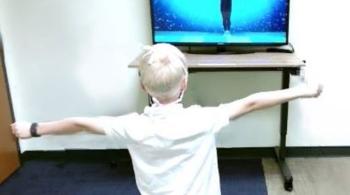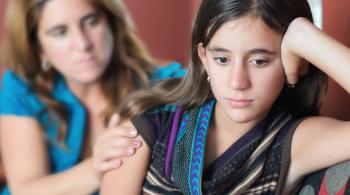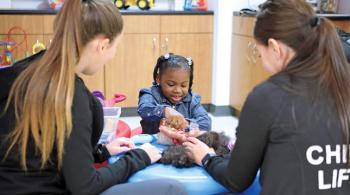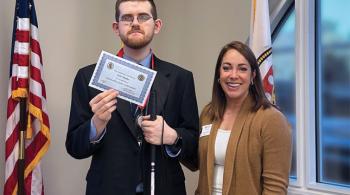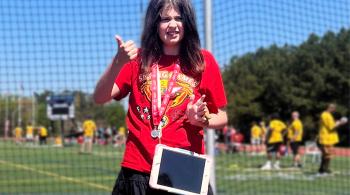On this month’s episode, we are going to discuss Functional Neurological Disorders or FND. Patients with this disorder are often stigmatized and, unfortunately, criticized for seemingly faking a disorder.
The reality is that the symptoms of functional neurological disorders are real, can cause significant morbidity, but, thankfully, can most often be remedied by prompt identification, education, and appropriate treatment.
Kennedy Krieger president and CEO, Dr. Brad Schlaggar is joined by Dr. Souraya Torbey, a child and adolescent psychiatrist in the Center for Developmental Behavioral Health and the director of the FND Clinic at Kennedy Krieger and Dr. Caitlin Thompson is a staff clinical psychologist in the FND Clinic. They are also joined by a parent of a child diagnosed with FND. Together the group will delve into FND and its impact not only on the individual but the entire family system.
View Episode Transcription
Dr. Bradley Schlaggar (BS): Welcome to Your Child's Brain, a podcast series produced by Kennedy Krieger Institute with assistance from WYPR. I'm Dr. Bradley Schlaggar, pediatric neurologist, and president and CEO, Kennedy Krieger Institute. One of the recurring themes of this podcast series, Your Child's Brain, is that all behavior comes from the brain. There can be no behavior without the brain. In addition, the brain is the source of cognition, thought, creativity, emotion, language, movement, and so on. In real terms, the functions we attribute to the mind are indeed brain functions. Yet there are long held beliefs about the human mind being separate from the brain that while the brain is tangible, and functions mechanistically, the mind is somehow in the ether, and does not abide by the physical mechanisms that rule the brain's functioning. One of the consequences of this belief system is the idea that there can be disorders of cognition, thought, language, movement, etc that are not due to the brain's dysfunction, but instead are due to psychological or psychogenic mechanisms. Colloquially, you might hear someone say that a person's worrisome movements or behaviors, for example, are not due to a neurological problem, but instead are psychogenic are all in their head. Of course, since all behavior comes from the brain and the brain is indeed in the head, all in their head claim is technically right, but off target clinically. We know that the brain is the most complex biological system that exists. Of course, brain dysfunction will often follow the simple rules we ourselves have imposed on the brain to understand relatively common neurological conditions. We're especially comfortable diagnosing those patients whose conditions follow those rules. Yet many patients simply do not follow the rules, often coming to clinical attention with signs and symptoms that do not fit neatly into our disease and diagnostic categories. When this happens, and it does happen with some frequency, patients are diagnosed with psychogenic symptoms or conversion disorder where conversion refers to the idea that psychological factors like stress can get converted into physical or somatic, like referring to the body versus the mind manifestations. Another term we use for such seemingly brain related conditions that do not clearly have a neurological cause is functional neurological disorder. Importantly, patients with functional neurological disorder and related conditions are often stigmatized and unfortunately criticized for seemingly faking a disorder. The reality is that the symptoms of functional neurological disorders are real, can cause significant morbidity, and thankfully, can most often be remedied by prompt identification, education, and appropriate treatment. Today, we are going to delve further into this misunderstood and stigmatized disorder and discuss how functional neurological disorders can impact not only the individual, but the entire family system. I'm joined by two of my exceptional colleagues at Kennedy Krieger. They are Dr. Souraya Torbey, a child and adolescent psychiatrist in the Center for Developmental Behavioral Health, and the director of the Functional Neurological Disorder Clinic at Kennedy Krieger. Dr. Torbey is also an assistant professor at Johns Hopkins University School of Medicine. Dr. Caitlin Thompson is a staff clinical psychologist in the Functional Neurological Disorders Clinic, and in the Pediatric Psychology Clinic at Kennedy Krieger Institute. It is also my pleasure to welcome Emily Ford, parent of Lyla. Welcome Souraya, Caitlin, and Emily. Souraya, let's start with a definition. What is a functional neurological disorder? I talked a bit at the front end about the historical background. But could you elaborate a bit more and explain how have physicians and other clinicians referred to this disorder?
Dr. Souraya Torbey (ST): We diagnose psychiatric illnesses and neurological illnesses, some of them using the diagnostic and statistical manual, what we call the DSM. The working diagnosis right now for FND is having one or more sensory or motor symptom, that are incompatible with a known neurological disorder. We look for sensory or motor symptoms that really don't fit what certain disorders that we know. There are a lot of terms that have been used to describe functional neurological symptom disorder in history. One of the oldest terms is hysteria. At the time, it was thought to be a condition that only occurred in women, and hysteria is derived from the word uterus. It was thought that these patients have a wandering uterus that's resting on other areas of their body resulting in these symptoms. Another term is what you mentioned, Brad, conversion disorder, converting this inner mental state into some physical symptom. Later on, one of the terms that was used not even too long ago was psychosomatic illness, but even that term still promoted that dichotomy between the mind and the body. More recently, we have shifted to using the word functional and using the term functional neurological symptom disorder, which really the point was to eliminate this dichotomy between the mind and the brain. What it refers to is a miscommunication in the nervous system. One analogy that we like to use in our clinic is that it's a software problem, and not a hardware issue. Because the structures in the brain continue to be intact.
BS: That's a great set up because I'm interested in how you're thinking about the role of the brain. The hardware seems to be intact, so it's a software issues. Let's speak about the role of brain function in functional neurological disorders, and how that role informs the way that we now think about how these fairly common clinical conditions present and how they align with more conventional clinical categories like psychiatric and psychologic and neurologic.
ST: The recent research, what we know, basically now to this day is that we have found some structural brain changes in the brain and increased activity in certain areas of the brain that are related to the processes that are responsible for the emergency circuitry. What we know is that this threat response is reactivated in patients with FND in the brain. The area for fear, anger, pain, sadness, and vigilance. What happens is the system gets turned on, and it stays on, and it's now really easily triggered and much harder to turn on. This is the process by which we think the neurologic symptoms emerge. That being said, FND can't just be explained by one simple cause effect pattern. There are a lot of different factors that interact and result in the symptoms. Some of these factors can be biological, some of them can be psychological, some of them are social. When we approach FND, we approach it what we call the biopsychosocial approach. Taking into account all of these factors including the brain processes.
BS: Caitlin, let's talk about symptoms of functional neurological disorders. What kinds of symptoms do we see and what challenges do children and adults with this disorder face?
Dr. Caitlin Thompson (CT): We see different categories of symptoms with FND. Some people present with motor symptoms, and those can be things like weakness or paralysis or different types of abnormal movements or challenges with gait. Some people may have more sensory symptoms, and that may look like a feeling of numbness or loss of sensation somewhere in the body. Can also be changes in vision or hearing or sense of smell. We also see challenges with speech. Some patients also have what are called functional seizures, or non epileptic seizure episodes. These are episodes of abnormal shaking or convulsing that sometimes include loss of consciousness, or staring episodes that might look like an epileptic seizure. But on imaging, we see that there isn't actually any electrical discharges in the brain, like we would see in epileptic seizures. Some people also have episodes of non responsiveness, where it might look like syncopy or like they're passing out. What we do know is that sometimes people may have one symptom, and then they develop other symptoms, or we see symptoms changing over time. I think a lot of youth we see have a variety of symptoms, have more of a mixed presentation. Because of all these different types of symptoms, as I'm sure you can imagine, there are a lot of challenges that youth face. It can be challenges with mobility. They may need to use devices to help them walk. They may have challenges doing those activities of daily living, things around the house. We see a lot of challenges with school, trouble getting to school, trouble doing work. Lot of impact on social relationships, which we know for youth is really important. We see a lot of bullying, unfortunately. There's a lot of challenges with family functioning. FND just doesn't affect only the youth, but also the family as a whole. We know that caregivers are often missing work. There's financial strain. You just aren't able to engage in a lot of the activities that they typically would, things like playing sports or doing hobbies or hanging out with their friends.
BS: Caitlin, how common of a diagnosis are we talking about for functional neurological disorders and do you perceive it as underdiagnosed or over-diagnosed? What are your thoughts?
CT: There's a range of prevalence rates. It used to be thought that it was somewhere between one and seven out of 100,000. A recent study that came out last year found that up to 18.3 youth out of 100,000 were diagnosed with FND. We see that up to about 10% of kids who present to pediatric neurologic clinics have FND and up to 20% of kids presenting to epilepsy clinics have FND. We see an increase in rates over time, I think, especially following the COVID-19 pandemic. I do think that there are some challenges with misdiagnosis. As Souraya is going to talk about a little bit more, there's often a lot of extensive medical workup that youth are going through before they're diagnosed, and this can really lead to a lot of delay in diagnosis, it can lead to misdiagnosis. We know that delay and that uncertainty can be really challenging. I think we're getting better at diagnosing and understanding what it is because of that we may see some increasing rates.
BS: That's the issue of diagnosis. It used to be considered that these disorders were considered diagnoses of exclusion. Caitlin made the point of all this work up that would have to happen to rule out everything that clinician can think of before coming to the conclusion that all that's left is a functional neurologic disorder. What are your thoughts about diagnosis of exclusion, and in general, why is it difficult to make a diagnosis?
ST: Like Caitlin mentioned, really, some of the delays sometimes in treatments and patients seeking answers from multiple providers can sometimes be a little bit challenging with reaching a diagnosis. One of the difficulties is that shift really with physicians in the way that we approach FND, moving from that diagnosis of exclusion to a diagnosis where we're actually actively searching for symptoms and characteristics that are in line with this diagnosis to make the FND diagnose. If we take these symptoms alone, like FND symptoms alone, the physical symptoms are very similar to some organic presentations or other neurologic disorders, and that's where the confusion comes from. Sometimes physicians want to make sure that they're not missing anything, so the workup tends to be extensive. That means that we really need to learn as physicians and a new clinical pattern of what to look for and the positive signs that indicate this disorder. At the same time, we really need to make sure that we're getting a very detailed and careful examination of what we said, what we talked about before, like those biopsychosocial factors so the social and familiar context also to confirm the diagnosis.
BS: Caitlin, are there consistent triggers for functional neurological disorders manifesting?
CT: We do see a range of different triggers. I think something that's important to note is that in previous criteria for the diagnosis, it used to be that there had to be an identified psychological stressor that occurred prior to the start of symptoms. We know that that's true for some people, but it's not true for everyone. I think it's really great that our new criteria don't include that stressor as a requirement. But thinking about that biopsychosocial model, we know that there really are a lot of different predisposing factors. We know that psychiatric symptoms can be a predisposing factor, things like anxiety and depression, but also just experiencing general life stressors, things like school stressors, pure family stressors. We do know that some people have a trauma history and that trauma history can be a predisposing factor, but again, not everyone has a trauma history. We know that history of somatic symptoms, so having things like chronic pain or fatigue or how caregivers respond to those somatic symptoms can be predisposing factors. Then there are these symptom monitoring factors that come into play. Oftentimes, we see youth who are really focusing a lot on what's happening in their body. They're monitoring what's happening. They maybe focus a lot on external body features. Then there are some neurobiological factors as well. Increased attention to the areas that are affected, beliefs about illness, expectations about illness, feeling that they have a lower sense of control over their bodily actions. Then, like Souraya mentioned, there are some of those functional and structural brain abnormalities as well.
BS: Speaking with you Caitlin, is there any factors that make you more likely to develop FND, age, sex, gender, curing conditions?
CT: Yes. We do see that FND is more common in females. In youth, at least, we see that it tends to be a little bit more common in teens than in younger children. Different studies have found a mean age being somewhere between 13 and 15 for the symptoms. Like I mentioned, there can be psychiatric comorbidities. Again, there can be this misunderstanding that everyone with FND has some type of psychiatric disorder. We know that actually kids with FND have lower prevalence rates of psychiatric disorders than adults with FND, but again, we do see some of those comorbidity. Things like adjustment disorder, anxiety, depression, neurodevelopmental disorders, and also just sometimes having maladaptive coping skills. Just really having trouble coping with different things that are happening in their lives.
BS: You mentioned earlier this concept of the brain threat response system, ramping up and staying up as one of the ways of thinking about mechanisms for FND. Can you expound on in general causes of FND?
ST: FND really can't be just viewed as one cause. We really need to look at it as a multi factorial diagnosis. There's the activation of the emergency circuitry that plays a role. Other factors that play a role, Dr. Thompson, Caitlin, mentioned them a little bit before, were, for the example, exposure to illness, injury, dysregulated mood, anxiety, symptom expectation, other stressors like major life events, breakups, the family's response to symptoms can sometimes also reinforce and make the symptoms more challenging to treat. These factors, they really vary from one patient to another. There's a set of factors that when they can occur together, they set off that reflex response that we talked about. Really, all different factors that can come together and then result in the activation of that emergency response.
BS: Before we go on to discuss treatment and therapies for FND, I'd like to bring Emily into the discussion. Emily, thank you again for joining us and being here to share your story. Let's start out, just tell us about Lyla.
Emily Ford (EF): Sure. Lyla is she just turned 14. We've been we've been dealing with FND for a few years. She developed it when she was 11. She was just going into middle school. Lyla is sweet and kind. From the get go, I would call her just a nervous, timid, little, sweet soul, always.
BS: What kinds of issues cross the threshold where you said, it's time to come in and seek attention at Kennedy Krieger or elsewhere?
EF: Lyla is an interesting case. When she was 17 months old, she had a growth on her brain removed because she would have seizures. They were complex partial seizures. We didn't know what we were looking at. At first, they thought she was just epileptic but then they did find that there was something there. She actually had brain surgery at 19 months old and would get regularly checked with MRIs every year, then every two years. We were about to just totally be cleared from that, the Friday, his first week of school, that Friday evening, she had something, we just call it the event. But she was outside in the pool with my other daughter in between the pool and the hot tub, they like to do that, and she became very lethargic and then she wasn't really able to walk right. Her gait totally changed and she also said her head was really hurting. I think we took her into the hospital pretty quickly because in our mind, there was that fear of, oh my gosh, something's back with the brain growth. That got us in there pretty quick. They had to do some tests and stuff, but we've been through the gamut. Our first was quite a stay in DC Children's, and then we ended up in Kennedy Krieger for quite a stay, and she did a bit of time at Hopkins too.
BS: Can you share the ways the clinic suggestions or recommendations positively impacted Lyla and your family, and how the concept of this kind of a diagnosis, how you processed it and perceived it initially, and how that's evolved over time?
EF: FND or FNFD doesn't really make any sense. It's so frustrating. First to understand that, okay, my child, when she's totally distracted and not focused on anything that might be bothering or worrying her, she might be able to run across the yard or jump on a trampoline, and it looks like she's totally fine and healed. Then a few minutes later, she might not be able to walk. It's been really difficult to wrap your mind around that it's a miscommunication in the nervous system, not actually a growth or something biologically wrong. The doctors are really helpful in helping us to really not respond to when we might see a new symptom or we might see a flare up of a symptom. Because as a parent, you worry and you ask more questions, and you try to get to the bottom of it. But with us, it's like you notice it and you put it in the back of your mind but you don't really show that you're worried, you don't really let her know in any way that there's a symptom that something's different. I will say that having had so much practice in that, I actually think that my mind doesn't go straight to worry now, because I'm making myself not do that. I'm trying to avoid that for her. My mind doesn't go to worst-case scenario anymore. It's just like, I've noticed this, and we're going to do the best we can and just keep moving forward.
BS: What would you say to other parents who have similar concerns or maybe just getting started on their own journey with a child who has a functional neurologic disorder?
EF: I would say to be patient with your child. Certainly be patient with yourself. A lot of grace, and it gets better for sure.
BS: How would you describe your hope for the future for Lyla and your family at this point?
EF: To have her totally healed and not ever symptomatic again is certainly my hope. Healing, all the way.
BS: Thank you for that. Caitlin, let's get back to you. Let's talk more about we heard some of the experience of treatment approach, but how do we treat children and teens with FND? What's your approach?
CT: Because of all of the different systems that are involved in FND and all the different symptoms that we see in that biopsychosocial lens, we really need to take a multidisciplinary approach to treatment. Typically, that includes a rehabilitation approach. It's working with a team of providers to manage all the different areas that can be impacted. Most of the youth that we work with are doing some type of rehabilitation therapy, whether that's physical therapy or occupational therapy, or speech, and they're working on mobility. They're working on trying to fade out assistive devices, getting back to activities, gradually increasing what they're doing physically, working on those activities of daily living. We know that psychological interventions are really important components. Things like cognitive behavioral therapy where we're focusing actually on how to manage the symptoms themselves, so learning different physiological relaxation strategies, understanding the relationship between thoughts and emotions and physical symptoms and behaviors and trying to change those relationships. Doing things like habit reversal training to use competing responses so opposite actions for certain symptoms. Working on those psychiatric comorbidities that might be happening. Working on managing the anxiety and depression symptoms with cognitive behavioral therapy, having psychiatry, like Souraya involved for medication management of those psychiatric comorbidities. Then also a lot of families really benefit from working on our team, at social work or with a psychologist for family therapy. Knowing that again, FND doesn't just impact youth but impacts the family as a whole. Working on those pieces, we get education really involved to help address all of the school challenges that can come with FND. I think overall, the important message with treatment is that we really want to focus on increasing functioning. We're not necessarily going to fix the symptoms or get rid of them right away but instead, we're going to get back to functioning gradually. The more we get back to functioning, the more we see a decrease in those symptoms.
BS: You really made a strong case for the interdisciplinary care that goes beyond therapy services, goes beyond medical, it includes educational systems. It's really a truly interdisciplinary, broadly speaking, approach to care. What kind of success rate do we have? How often do patients make the full recovery.
CT: The great thing is that we see that the majority of youth do recover from FND, especially when they're working with that multidisciplinary team and really addressing all of those factors. Sometimes if we're just focusing on one aspect and not everything, we maybe don't see the progress that we want to, but when really we're addressing all of those components, you do really have a good prognosis. Many will fully recover and never experience symptoms again. We know that some people may have relapses but oftentimes they find, hey, I've got my plan, I know what to do. I know how to manage my symptoms. This is what I'm going to do, and they can work through maybe a relapse or a flare in symptoms, and then also achieve remission over time.
BS: We hear the term often use multi system dysfunction, and there are other multisystem disorders, fibromyalgia, long COVID, for example. How does functional neurological disorder fit in to those other multi system disorders? And what do we mean by multi system dysfunction?
CT: The way that we view this principle of multi system dysfunction is that the emergence of the symptoms is really coming from complex interactions within multiple system levels. For example, we have the motor system, the sensory, the gastrointestinal, the urinary. Even in the brain itself, there's dysfunction at several levels. For example, the circadian rhythm, which regulates our sleep can dysfunction the autonomic nervous system, leading to difficulties with regulating heart rate and blood pressure, the inflammatory immune system, the stress system. They all play a crucial role together with the presentation that we eventually see in fibromyalgia or functional neurologic symptom disorder or post COVID symptoms where there are multiple different symptoms that come together, and when they cluster in a certain way, they present for a certain diagnosis.
BS: Souraya, could you elaborate a bit more on the brain based mechanisms that underlie the fibromyalgic response?
ST: We talked a little bit before about FND. A little bit of a similar process takes place here. FND is due to an imbalance in emergency signaling circuitry, which we talked a little bit about before. Pain is one of the major emergency signaling processing. When an individual has an injury, what happens is that the injured site will send signals to our brain. But what happens in chronic pain, which is fibromyalgia, signaling is now occurring in the brain independently of new peripheral injuries. Part of responding to pain in the end is also shutting down that response and when the pain is no longer useful. What happens in fibromyalgia is that these signals get turned on similarly to FND, and they are not getting turned off, and this leads to various and multiple symptoms that we see.
BS: Caitlin, what would you say are some of the most significant myths and misapprehensions that you come across both in clinic and outside of clinic?
CT: I think within clinic, within the youth we work with, there's a lot of stigmatization. A lot of patients or youth that we see have been told that they're faking it. That it's all in their head, that it's just because you're stressed or anxious. That's really invalidating. Youth we work with have been told that by medical professionals. I think there still is even though the criteria have changed, there's still this belief that it's some psychological stressor that's leading to diagnosis. I think there is this thinking for some people that there must be some traumatic experience that happened that's triggering this. We have families who say, Oh, no, was my child abused? Was there something that happened that I wasn't aware of? Which again, is not always the case. Most often not the case. Occasionally, we see that. Then a lot of families worry that there is something else going on, and are the doctors just missing something, and there is something else going on that's leading to these symptoms? Then I think there's a lot of worry to, like, am I going to be dealing with this for the rest of my life? Am I ever going to get better? Then I think in the larger society, we see a lot of negative portrayals of FND in the media, which I think just leads to further stigmatization.
BS: That really makes the case for an important role for friends and family members to help with individuals with FND. How do you go about rallying family and friends to be supportive as patients are coming to terms with this condition, the questions that they might have about it and and worries about chronicity, for example.
CT: I think a lot of that really stems from beginning with education about FND, what it is, what it isn't and helping people understand what youth are going through, that they're not faking it, that a lot of these things are out of their control, but that they can work to gain control over their symptoms. Like Emily said, a lot of it is working with parents on how to respond to symptoms. Not constantly asking about or paying attention to symptoms, and instead focusing more on functioning and ways to more adaptively cope. We know that having family members and school staff and friends really encourage that return to functioning. Using a paced approach is important. For parents, especially, we often teach scaffolding, so knowing that they may start off providing more support, and then over time, they're decreasing their support so that kids are doing more independently. We're really trying to have friends and family and school personnel really shift that focus away from the symptoms and toward functioning.
BS: Souraya, let's end with this question. I think it's always the most enjoyable question. It has to do with optimism for the future via research. What kind of research is being done in this field that makes you excited for the future?
ST: I think we're in the midst of a revolution and research with FND. There's a lot more interest towards FND nowadays, with the stigma going down and really understanding this diagnosis better. We know a lot more now than we did 20 years ago. There's a lot of research being done in identifying circuitry, the neurobiology through neuropsychological testing, PET scan, fMRI imaging, genetic testing. Really looking for some biomarkers that can help us understand it better. There are also a lot of novel treatments being studied like psilocybin or transcranial magnetic stimulation for FND, and a lot of different types of cognitive behavioral therapy that have been shown. Some of them have already been shown to be effective, and others are being studied currently, and really understanding the needs of our patients and creating systems of care that meet those needs.
BS: That's an excellent place to end. I want to thank our guests, Dr. Souraya Torbey and Caitlin Thompson and Lyla's mother Emily. We hope that you our listeners have found this discussion about functional neurological disorders interesting and informative. Please check out our entire library of topics on your child's brain at wypr.org, KennedyKrieger.org/YCB or wherever you get your podcast. You've been listening to Your Child's Brain. You child's brain is produced by Kennedy Krieger Institute with assistance from WYPR and producer Spencer Bryant. Please join us next time as we examine the mysteries of your child's brain.


